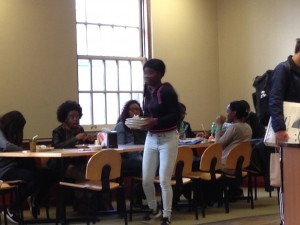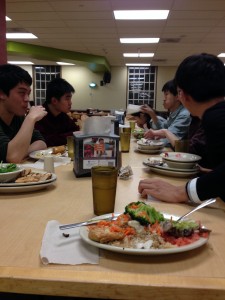I went to a high school that was predominantly composed of White students. I was the one of the few Asians and the only Chinese at my high school. Most white students at my high school had never talked to any Asians before, except when they went to the Asian market stores. People were curious of me. Since I was still learning and not quite fluent in English, some white students found my pronunciation of words funny. As a student without any distinctive athletic talents and instrumental abilities, I found myself having troubles making friends quickly. I ended up making friends with the kids on the marching band, which was considered “not cool” at that time. Even though I associated closely with my group, the other group, that was mainly composed of affluent white kids with outstanding athletic abilities, treated me nicely as well. With the curiosity about China, they often came to me and asked about things about China. Some example questions are “Do you guys give away computers for free in China?”, “How big is China?”, “do you guys eat cats?”. Overwhelmed by all people with different questions, I was so excited that I did not realize how ridiculous some of those questions were. As people got to know me better, they started to imitating or even exaggerating the way I spoke English. They made fun of my accent mainly to be funny and they thought I wouldn’t mind since I shared good friendships with them. However, my feeling was actually hurt inside, but since I was the only Chinese and a lot of white students were doing the same thing, I just told myself to be tolerant. I attributed all the blames to me because I thought it was my fault to not be able to speak English properly. Life went on. During my senior year in high school, I was finally able to speak English fluently without too much accent. Though, in some days, some of my white friends still made fun of Asian stereotypes at the lunch table. I would mock back at my friends most of the times, but sometimes I would just give them stares because I knew they were just being funny.

Looking back at my high school experiences, I see and realize racism I have not noticed at the time, using knowledge of racial identity I have learned from my seminar course “Color and Money”. I recall the times that my white friends made fun of the Asian accents and squinty eyes some Asians have, that some faculty members at school made jokes on some Asian stereotypes and that people kept coming to me with similar questions that they may or not realize are offensive and racist. Three months at Trinity College have rubbed down my edges and crushed out my enthusiasm and optimism of the world being perfectly equal both racially and socioeconomically. Fortunately, my understanding and perception on races and socioeconomic class have been deepened through my seminar course “Color and Money”. One of the books that had the biggest effect on my racial identity is a book called, “Unraveling the ‘Model Minority’ Stereotype”. The book mainly focuses on different groups of Asians, and how one group differs from another one. The book is especially inspiring for me because it helps me see the real structure of the whole Asian group. I thus have developed a better sense of racial identity from the book. for the last past three months, instead of becoming more defensive about my race and publicly denouncing racism, I decided to use the knowledge I have learned from my seminar course to observe and figure out the true situations behind the curtain of racism.
I do believe that Asians are the minority group in the U.S., but Asians are definitely not the minority group in the world, for that there are different countries around the world, and different countries have different dominant races. I am an international student from China, where there are also dominant groups and minority groups. In fact, I am of the dominant group in China. During the past year at Trinity, my interactions outside the classroom are mainly with people of my race. I felt excluded when I first arrived at Trinity because none of any white kids had invited me to hang out with them. I felt left out that when everyone else went to the frat parties on Friday nights, none of the people at my floor invited me to tag along. I thought that people were racist and that they did not invite me because of my skin color. After talking to several of my white friends about this issue, I gradually came to the realization that I was wrong. Those of my white friends confessed that they also had trouble making friends at first because freshmen tend to stick with the group that they are already familiar with instead of stepping out of their comfort zones and making new friends. I realized that I was not doing well on my part of trying to make new friends. For instance, Frat parties are usually where people meet people and make new friends, but I don’t like frat parties and always play basketball with my Chinese fellows on Friday nights. Since I don’t go to frat parties, I give up the major opportunity of meeting new people and making friends.


People constantly bring up the Mather issue, which talks how people of different races tend to sit separately at Mather Dining hall. People of color, mainly African American students, on Trinity school campus had organized multiple protests against racism on the college campus. They took the case of Mather issues and encouraged people of color to sit with white students at Mather dining hall. I think it is beneficial for both students of color and white students to get to know each other by sitting together at Mather. However, it is not something that can last. people of different races share different cultural roots, even if they may be born in the same country. people make friends with each other because they share the same interests and point of views. If two people do not share the same interests, sitting together just for the purpose of making Trinity College a “racial friendly” college is not the way to go. I think after devoting all energies towards classes and writing papers, sitting with the people you can easily laugh with is what students wish the most. For example, I am an international Chinese student who was brought up in a conservative environment where academic success is the unquestionable priority. I am not interested in the party culture at all. I enjoy talking to people from different racial or family backgrounds and hearing new things, but at the end of the day, my Chinese friends are who I feel most comfortable to talk to.
With all that being said above, I am not suggesting that racism does not exist at Trinity. However, I personally dislike the idea of frequently having big protests and parades. All the time I have spent at trinity and in my first seminar class has taught me that racism has existed for as long as you could imagine. Instead of being too extreme on criticizing the existence of racism, I think both white people and people of color need to think in each other’s perspective. People keep criticizing white students for not approaching and sitting with students of color during lunch but miss the fact that students of color are lacking the motivations and desires to sit with white students. In Tatum’s book “Why All All the Black Kids Sitting Together in the Cafeteria?”, Tatum introduces five stages of black racial identity development and six stages of white racial identity development. I think people of color at Trinity are mainly on the internalization stage where they are secure with their racial identity and are willing to make friends with white people who are respectful. Most white students at trinity are between contact stage and disintegration stage. Even though most of them have gone to either boarding school or college prep school, the limited amount of interactions with people of color leads to the lack of awareness on white privilege and racial problems on Trinity Campus. Both white students and students of color need to realize that racism is not caused solely by one group of people. people with different races own responsibilities on the problem of racism.
“Color and Money” has helped me gain a clear self-racial identity. Now equipped with better knowledge of racial identity than ever, I take the great interest of racial problems around the world. Trinity is only a start.
Works Cited
Beverly Daniel Tatum. Why Are All the Black Kids Sitting Together in The Cafeteria? Basic Books. Print.
Stacy J. Lee. Unraveling the “Model Minority” Stereotype. 2nd ed. Teachers College Press, 2009. Print.